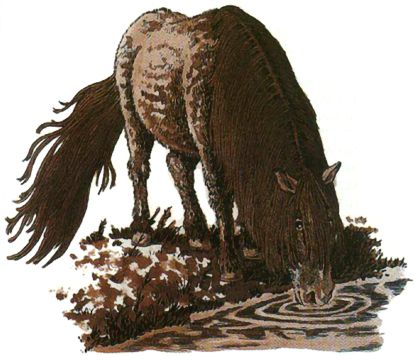

Dragon #269

| Riding Pony | War Pony | |
|---|---|---|
| Poney de selle | Poney de guerre | |
| Climate/Terrain: | Halfling inhabited | Halfling inhabited |
| Frequency: | Rare | Rare |
| Organization: | Herd | Herd |
| Activity Cycle: | Day | Day |
| Diet: | Herbivore | Herbivore |
| Intelligence: | Animal (1) | Animal (1) |
| Treasure: | Nil | Nil |
| Alignment: | Neutral | Neutral |
| No. Appearing: | Variable | Variable |
| Armor Class: | 7 | 7 |
| Movement: | 12 | 12 |
| Hit Dice: | 2+2 | 3+3 |
| THAC0: | 19 | 17 |
| No. of Attacks: | 1 | 2 |
| Damage/Attack: | 1-2 | 1-4/1-4 |
| Special Attacks: | Nil | Rear kick (2-8) |
| Special Defenses: | Nil | Nil |
| Magic Resistance: | Nil | Nil |
| Size: | M | M |
| Morale: | Average (10) | Average (10) |
| XP Value: | 35 | 65 |
The halfling pony is famous for its tenacity and toughness. The breed is said to come from wild mountain stock, which accounts for its endurance and sure-footedness. The halfling breed is also much more affable than its wild ancestors and more at home in the rolling hills and open plains. Their halfling name, pennig, is simply the halfling word for pony.
Halfling ponies come in various colors, although the majorities are a warm chestnut brown. Their coats are shaggy and need frequent brushing to look their best. In harsh conditions, however, their shaggy coats provide excellent protection against the elements. Their mane and tail are quite long, and their forelocks spread out over their foreheads, concealing their eyes. Halflings never trim their ponies, allowing the mane and tail to grow to the ground, though these are often braided.
Halfling ponies make superb mounts, as they are hard workers and unlikely to bolt in the face of danger, sometimes to their detriment. Some critics of the pennig say that they are too stupid to be afraid, although halflings claim that the pony’s loyalty and bravery are the reasons.
Combat: The halfling pony attacks with a bite or by slashing with its hooves; either attack inflicts 1-2 points of damage. Riding ponies are not trained to attack while carrying a load.
The halfling war pony is a much more dangerous animal, with two hoof attacks against opponents at its front, each inflicting 1-4 points of damage. Any enemy unlucky enough to be facing the war pony’s posterior might find himself or herself on the receiving end of a nasty kick. Using both hind legs, the war pony gains a +2 bonus to hit and causes 2-8 points of damage. The war pony can use either the front hooves or hind hooves in any round, but never both in the same round.
Habitat/Society: Although it was originally bred from wild mountain pony stock, the halfling pony is normally found in rolling hills or grasslands. There are occasional feral herds that can be captured and broken, but most halfling ponies are found in towns and cities. Halfling war ponies are harder to find, however, as the breed’s agreeable nature makes them difficult to train for combat. Halfling ponies are usually trained as war ponies by special order through halfling breeders. This takes at least 2 years, as combat training starts when the pony is a foal. This is rarely undertaken simply to sell the pony on the open market, and few adventurers who have invested the time and money into acquiring one of these mounts would be willing to part with it for any price. Only in a large city stable would one have a chance of finding a halfling war pony for sale, and its cost is typically twice that of a normal war pony. Such ponies usually come up for sale only if their original owner dies, and it's a rare war pony that doesn't die with its owner.
Halfling ponies live about as long as their mundane cousins, and their birth rates and gestation periods are about the same. The one main difference is that hard work does not seem to lessen their lifespan by any appreciable amount, or even tire them much. The halfling pony is capable of carrying more weight than the average pony. It can move at full speed while carrying 180 lbs., half speed at 265 lbs., and one-third speed under a burden of 350 lbs.
Ecology: Because of its nimble-footed ancestry, the halfling pony can move over mountainous terrain or narrow bridges that might hamper other ponies or horses. They are also quite willing to follow their owners into dungeons or caverns, being used to the underground homes of their halfling breeders.
